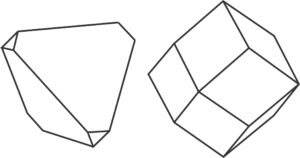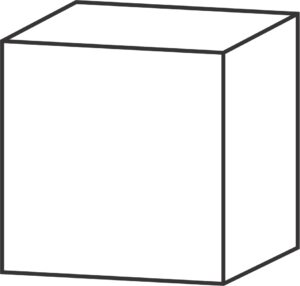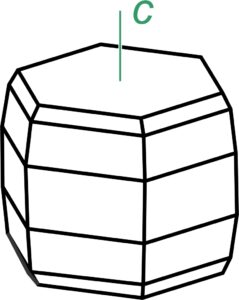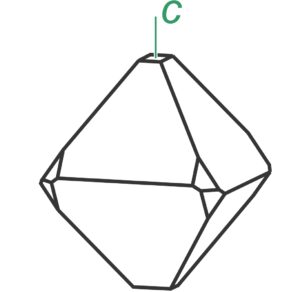10 Sulfides
10.1 Sphalerite
Occurrence—An important ore mineral, sphalerite is found in hydrothermal deposits and in some contact aureoles.
Distinguishing Features—Distinguishing sulfides from oxides in a thin section is challenging, and distinguishing the different sulfides is even more challenging.
Sphalerite may be opaque (brown-red to black in reflected light) or transparent. It is normally yellow, yellow-brown, brown or black; more rarely gray or colorless. It has has extremely high relief, and is isotropic.
Irregular masses are common; euhedral crystals less common. It may show complicated cleavage patterns because of six good/excellent cleavage directions.
Similar Minerals—If opaque, sphalerite may be hard to distinguish from other reddish-brown opaque minerals. If transparent, it may be confused with rutile, although rutile is not isotropic.

Optical Properties
■■ Cubic; isotropic to opaque
■■ n = 2.39-2.47
10.2 Pyrite
Occurrence—Pyrite is a common accessory mineral in many igneous, metamorphic and sedimentary rocks.
Distinguishing Features—Distinguishing sulfides from oxides in a thin section is challenging, and distinguishing the different sulfides is even more challenging.
Pyrite is one of the few relatively common yellow-gold sulfides. It is opaque in transmitted light, and bright yellowish-white or brassy in reflected light.
Crystals are often square, triangular, or rectangular in cross section.Pyrite may show one poor cleavage; subconchoidal fracture common.
Pyrite commonly alters to reddish Fe-oxides/hydroxides, especially on grain margins.
Similar Minerals—Pyrite may be difficult to tell from other sulfide minerals, especially chalcopyrite, marcasite, or pyrrhotite, as well as oxides and other opaques. If reflected color can be seen, pyrite and other sulfides appear yellow/brass/golden and oxides appear black/silvery.

Optical Properties
■■ Cubic; opaque
10.3 Pyrrhotite
Occurrence—Pyrrhotite is typically found in mafic igneous rocks and in some reduced metamorphic rocks. Less commonly it occurs in hydrothermal veins or contact aureoles.
Distinguishing Features—Distinguishing sulfides from oxides in a thin section is challenging, and distinguishing the different sulfides is even more challenging.
Pyrrhotite is opaque and has a bronze to copper-red color in reflected light.
It may occur in masses, blades, or as disseminated grains. It is strongly magnetic.
Pyrrhotite has one poor cleavage, uneven fracture.
Similar Minerals—Pyrrhotite is similar to some other sulfides, but the bronze to reddish color (reflected light), if visible, may be diagnostic. It may be confused with oxides, but oxides have black or silvery colors.

Optical Properties
■■ Hexagonal, opaque
10.4 Chalcopyrite
Occurrence—Pyrite is found in most sulfide deposits, and also in hydrothermal veins or as a replacement for other minerals.
Distinguishing Features—Distinguishing sulfides from oxides in a thin section is challenging, and distinguishing the different sulfides is even more challenging.
Chalcopyrite is opaque, and has a bright strong yellow color in reflected light. Its color is darker than the color of pyrite.
Chalcopyrite rarely form euhedral crystals; massive crystals are typical. It has one poor cleavage that is rarely seen in thin section; fractures are common.
Similar Minerals—Chalcopyrite is similar to pyrite, but its color is more yellow. It is sometimes also confused with marcasite or pyrrhotite.

Optical Properties
■■ Tetragonal; opaque